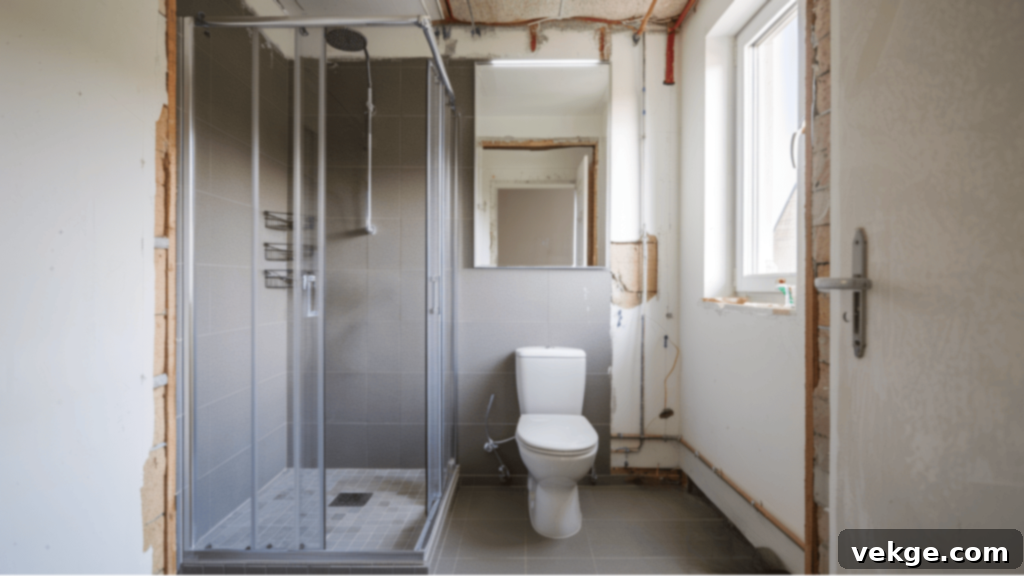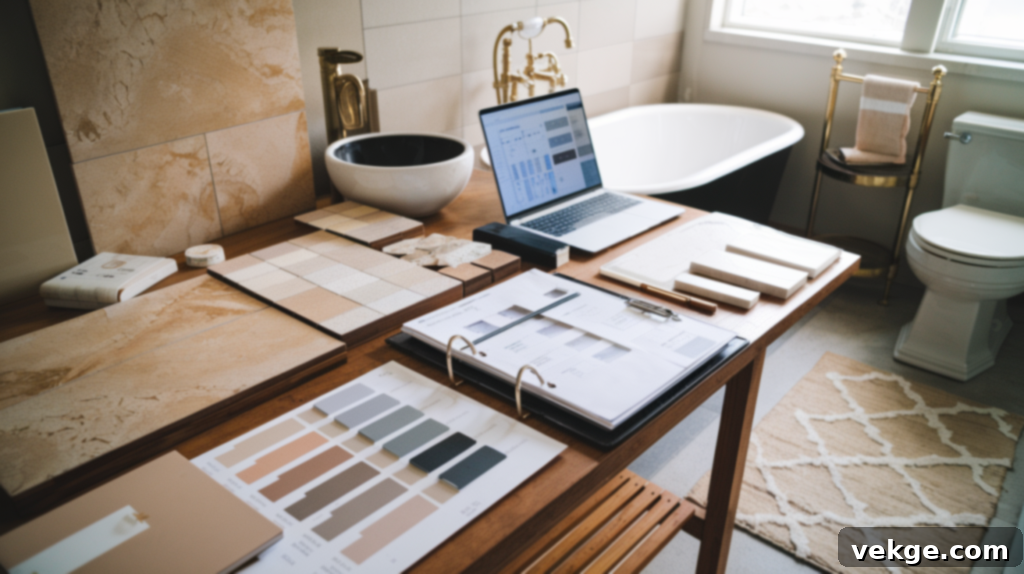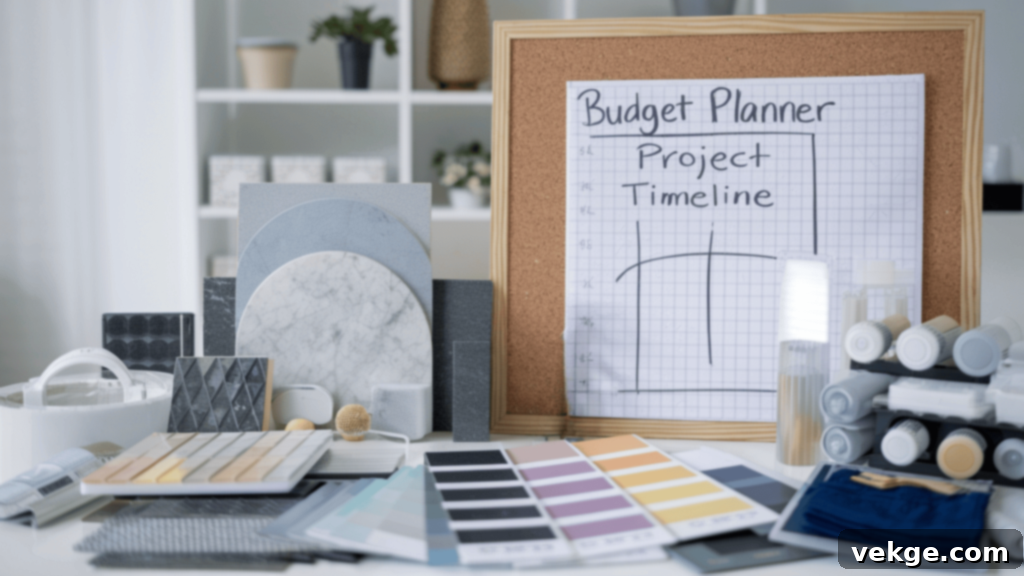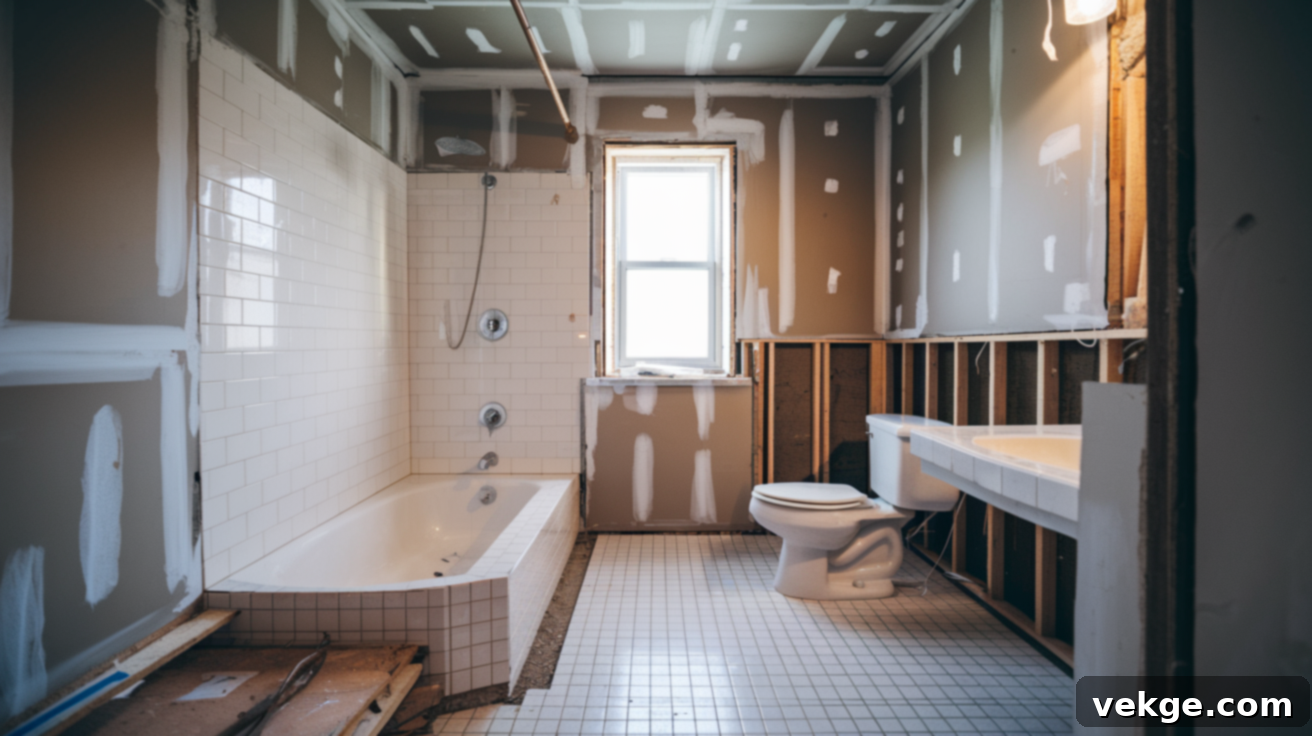How Long Does a Bathroom Remodel Take? Your Ultimate Guide to Project Timelines
Embarking on a bathroom remodel is an exciting venture that can significantly enhance your home’s comfort and value. However, one of the most pressing questions for any homeowner considering this upgrade is, “How long does a bathroom remodel take?” Understanding the timeline is paramount, as it allows you to plan effectively, manage expectations, and minimize disruptions to your daily life.
Whether you’re envisioning a quick cosmetic refresh or a comprehensive overhaul, having a clear grasp of the typical duration, the factors that can influence it, and strategies to keep your project on track is invaluable. This guide will walk you through the various types of bathroom renovations, delve into the key elements that can speed up or slow down the process, and offer practical advice to ensure your remodeling journey is as smooth and efficient as possible. Drawing from practical experience, we’ll equip you with the knowledge needed for a successful bathroom transformation.
Bathroom Remodel Types: Understanding Their Timelines and Scope
Not all bathroom remodels are created equal, and consequently, their timelines vary dramatically. The duration of your project largely depends on the scale of the space and the extent of the work involved. From minor updates to major structural changes, each type of remodel presents its own set of challenges and scheduling considerations.
Below is a detailed breakdown of common remodel types, the typical space they involve, their estimated timelines, and specific notes to help you gauge your project’s scope:
| Remodel Type | Bathroom Space | Typical Timeline | Key Considerations |
|---|---|---|---|
| Simple Cosmetic Update | Powder Room / Half Bath | 3–7 Days | Focuses on aesthetics; includes painting, new fixtures (faucet, light), minor flooring changes, and vanity swaps. No major plumbing or electrical alterations. |
| Mid-Range Renovation | Guest Bathroom / Small Full Bath | 2–3 Weeks | Involves more significant changes like new tile (floor/shower surround), vanity replacement, upgraded lighting, and potentially replacing a tub or shower unit. May include minor plumbing adjustments. |
| Full-Scale Remodel | Master Bathroom / Large Full Bath | 4–8+ Weeks | A comprehensive renovation that often includes layout changes, custom cabinetry, moving plumbing or electrical lines, new shower/tub installations, high-end finishes, and potentially structural modifications. Requires permits and multiple trades. |
- Powder Room Updates: Quick and Efficient
These are typically the fastest projects. A powder room, or half-bath, usually lacks a shower or tub, simplifying the process. Updates often involve cosmetic changes such as a fresh coat of paint, swapping out the vanity and sink, installing a new mirror and lighting fixture, and perhaps updating the flooring. Since major plumbing or electrical reconfigurations are rarely required, these projects can often be completed within a week, making them an ideal choice for a quick home refresh. - Guest Bathroom Renovation: A Balanced Approach
Guest bathrooms, which typically include a shower or tub, fall into the mid-range category. These renovations often involve replacing existing fixtures, installing new floor and shower tiles, upgrading the vanity, and enhancing lighting. While more involved than a powder room update due to the wet areas and potentially more complex plumbing connections, they generally don’t require extensive structural changes. The timeline for a guest bathroom remodel can range from two to three weeks, depending on the availability of materials and the complexity of tile work. - Master Bathroom Transformations: The Most Comprehensive
Master bathrooms are usually the largest and most complex spaces to remodel. These projects often include significant layout changes, such as relocating the toilet or shower, installing custom-built elements like double vanities or walk-in showers, and incorporating high-end finishes. Such extensive work often necessitates permits, structural adjustments, and coordination among various skilled trades (plumbers, electricians, tilers, carpenters). Due to their intricate nature and the scope of work, master bathroom remodels can span anywhere from four weeks to two months or more, especially if custom orders or unexpected issues arise.
Understanding these distinctions is the first step in setting a realistic timeline for your bathroom remodel, allowing you to prepare adequately for the journey ahead.
Key Factors Significantly Affecting Your Bathroom Remodel Timeline

Beyond the general scope of work, several specific elements can significantly influence how long your bathroom remodel will take. Being aware of these potential timeline accelerators or decelerators can help you plan more effectively and mitigate unexpected delays.
1. Bathroom Size and Layout
The physical dimensions of your bathroom directly correlate with the amount of labor and materials required. A larger bathroom, by its nature, demands more time for every stage of the renovation process—from demolition and debris removal to framing, plumbing, electrical rough-ins, drywall installation, tiling, and final finishing touches. For instance, a spacious master bathroom with a large walk-in shower, a separate soaking tub, and a double vanity will naturally take longer to tile, paint, and install fixtures in compared to a compact powder room. More square footage also means potentially more complex design elements, which can further extend the time needed for meticulous execution and installation. The layout, even within a specific size, matters too; an intricate design with multiple angles or custom niches will require more precise work and hence, more time.
2. Complexity of the Remodel and Design Choices
The intricacy of your desired remodel is a major determinant of the project timeline. A simple refresh involves swapping out existing fixtures, whereas a complex renovation might entail altering the bathroom’s footprint, relocating plumbing lines, moving electrical outlets, or installing advanced features like a steam shower, heated floors, or smart home technology. Any changes to the fundamental layout of the bathroom or its utilities—plumbing, electrical, and HVAC—will require specialized labor, adherence to building codes, and often multiple inspection points, each adding days or weeks to the schedule. Custom-built elements, such as bespoke cabinetry, unique tile patterns, or specialized lighting designs, also require more time for fabrication, delivery, and precision installation, as opposed to off-the-shelf options.
3. Material Availability and Lead Times
One of the most common causes of project delays is the unavailability or late delivery of materials. In today’s global supply chain environment, specific tiles, custom countertops, unique plumbing fixtures, or even standard items can be backordered or experience shipping delays. High-demand items or those sourced from international suppliers often have extended lead times. To mitigate this, homeowners should ideally select and order all materials well in advance of the remodel start date. Proactive communication with suppliers and your contractor about expected delivery dates is crucial. Having materials on-site before demolition begins can prevent significant downtime and keep the project moving forward smoothly.
4. Contractor Scheduling and Workflow
The availability and management style of your chosen contractor can significantly impact your timeline. Experienced and reputable contractors are often in high demand, meaning their schedules might be booked out for weeks or months. Once a project begins, a contractor managing multiple jobs concurrently might have fluctuating availability, leading to gaps in workdays. It’s vital to have a clear understanding of your contractor’s proposed schedule, including start and end dates, daily work hours, and the sequence of various trades. A well-organized contractor with a reliable team and a structured project management approach can help maintain momentum. Conversely, a contractor with poor scheduling or communication can cause frustrating and costly delays. Always discuss expected timelines and a detailed work schedule during the hiring process.
5. Unforeseen Issues and Hidden Problems
Even with the most meticulous planning, unexpected problems can arise once demolition uncovers the underlying structure. Hidden issues like water damage, mold growth, outdated electrical wiring, corroded plumbing pipes, or structural deficiencies (e.g., rotten subfloor joists) are common culprits for unforeseen delays. These problems not only require immediate attention and additional repairs but can also necessitate calling in specialists (e.g., mold remediation experts), obtaining new permits, or undergoing additional inspections, all of which extend the timeline and budget. While impossible to predict every issue, a thorough pre-remodel inspection by an experienced contractor can often identify potential red flags early, allowing for proactive planning and reducing the shock of discovering major problems mid-project.
Planning for a Smooth Remodel: Essential Strategies
A successful bathroom remodel hinges not just on the quality of work but also on meticulous planning and effective communication. By proactively addressing key areas, you can significantly streamline the process and minimize potential headaches.
Pre-Planning, Design, and Material Research

Thorough pre-planning is the bedrock of any successful remodel. Begin by crystallizing your vision: what aesthetic do you want to achieve? What functional improvements are essential? Create mood boards, gather inspiration, and consider how the new bathroom will integrate with the rest of your home. Research materials extensively—from tiles and flooring to vanities, fixtures, and lighting—considering durability, maintenance, cost, and availability. Obtain multiple detailed quotes from reputable contractors, not just rough estimates. These quotes should outline the scope of work, material allowances, and a projected timeline. Crucially, aim to have all major materials selected and ordered before any demolition begins. This proactive approach ensures everything is on hand when needed, eliminating costly waiting periods and keeping your project on its intended schedule. Don’t underestimate the time it takes to make these decisions; rushing them can lead to regret or even change orders later, which are notorious for causing delays and cost overruns.
Effective Communication with Contractors and Tradespeople

Clear, consistent communication is the backbone of a stress-free remodel. From the outset, ensure your contractor fully understands your vision, expectations, and any non-negotiable requirements. Establish a preferred method and frequency for updates – whether it’s daily check-ins, weekly meetings, or email summaries. Don’t be afraid to ask questions, no matter how small; it’s better to clarify early than to fix errors later. Be open to your contractor’s professional advice and suggestions, as their experience can often provide valuable insights or more efficient solutions. Always document significant decisions, changes, or agreements in writing to avoid misunderstandings. A transparent and respectful working relationship fosters trust and allows for quicker problem-solving, which is critical for keeping the project on schedule and within budget. Setting clear expectations for work quality, safety, and site cleanliness also contributes to a smoother process.
Strategic Budgeting and Realistic Time Management

Your budget isn’t just about how much you can spend; it’s a critical tool for managing the project timeline. A detailed budget, established early on, allows your contractor to plan the scope of work realistically, allocate resources efficiently, and make material selections that align with your financial parameters. Crucially, always include a contingency fund—typically 10-20% of the total project cost—to cover unforeseen issues without derailing the project or causing financial stress. This buffer prevents work stoppages due to unexpected expenses. Similarly, time management involves more than just setting a target completion date. Break the project down into manageable phases (demolition, rough-ins, drywall, tiling, finishing) and assign realistic timelines to each. Track progress against these milestones and be prepared to adjust if necessary. Understanding that quality work takes time and that shortcuts can lead to future problems is key. By diligently balancing your budget with a realistic timeline, you empower yourself to achieve a successful and satisfying bathroom remodel without undue delays or financial strain.
Common Challenges During a Bathroom Remodel and How to Overcome Them
Even the most meticulously planned bathroom remodel can encounter unexpected hurdles. Being prepared for common challenges and knowing how to address them can save you time, money, and stress, helping to keep your project on track.
Addressing Unexpected Problems: Water Damage, Mold, and Structural Issues
Discovering hidden water damage, pervasive mold, or structural deficiencies once demolition begins is a common, albeit unwelcome, surprise during bathroom renovations. These issues are critical and must be addressed immediately to prevent further damage and ensure the long-term integrity of your home. Your first step should be to halt work in the affected area and bring in professionals, such as mold remediation specialists or structural engineers, for assessment and repair. This will undoubtedly add time and cost to your project. To mitigate the impact, ensure your budget includes a contingency fund for such eventualities. Proactive measures, such as a professional home inspection before the remodel, can sometimes flag potential issues early, allowing you to factor them into your initial plan and timeline, thereby minimizing the shock and disruption of mid-project discoveries.
Navigating Permitting and Inspection Delays
For significant bathroom remodels, especially those involving changes to plumbing, electrical systems, or the structural layout, local building permits are typically required. The permitting process can sometimes be lengthy and unpredictable, leading to frustrating delays. To stay ahead, apply for all necessary permits as early as possible in your planning phase. Ensure all documentation is complete, accurate, and submitted correctly to avoid rejections. Work closely with your contractor, who should be familiar with local building codes, permit requirements, and inspection schedules. Schedule inspections promptly as each phase of work is completed; delays in scheduling or failed inspections can bring the entire project to a standstill. Proactively understanding the local permitting process and maintaining open communication with your contractor and local authorities are crucial steps to preventing unnecessary hold-ups.
Conclusion: Empowering Your Bathroom Remodel Journey
Understanding “how long a bathroom remodel takes” is more than just knowing a number; it’s about gaining foresight, managing expectations, and empowering yourself for a smoother home improvement journey. We’ve explored the varying timelines for different remodel types, from quick powder room updates to extensive master bath transformations, and delved into the key factors that can influence these durations, such as bathroom size, project complexity, material availability, contractor scheduling, and unforeseen issues.
The essence of a successful, timely remodel lies in thorough pre-planning, clear and consistent communication with your chosen professionals, and realistic budgeting with a healthy contingency. By actively researching, setting clear expectations, and being prepared for common challenges, you can navigate your bathroom renovation with confidence and minimize stress.
Armed with this comprehensive guide, you are now in a much better position to plan your bathroom remodel effectively and keep it on track. Remember, a well-informed homeowner is a well-equipped homeowner. Take these insights, apply them to your project, and watch your vision come to life beautifully and efficiently. For more in-depth advice and practical tips on various aspects of home renovation, feel free to explore our other resources and guides.
